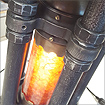 Spelunking the Mind of J.W. Kinsey: An exhilarating rollick through the methodologies, processes, and philosophies from J.W. Kinsey’s noodle. Be enthralled with an overload of ingenuity, inspiration, and indigestion! Read and feel your brain sizzle with holy ardor and zing!*
Spelunking the Mind of J.W. Kinsey: An exhilarating rollick through the methodologies, processes, and philosophies from J.W. Kinsey’s noodle. Be enthralled with an overload of ingenuity, inspiration, and indigestion! Read and feel your brain sizzle with holy ardor and zing!*
Collated and edited from various written interviews over the years.
*Maybe.
 What do you hope people experience when they engage with your work?
What do you hope people experience when they engage with your work?
A simple goal: shock and awe. To be mesmerized.
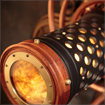 What initially sparked your passion for creating intricate mechanical artwork, and how did your aesthetic vision take shape?
What initially sparked your passion for creating intricate mechanical artwork, and how did your aesthetic vision take shape?
The impetus of my artistic journey is a simple one: I want to behold my whimsical, mechanical imaginings in the solid. I want to lounge somewhere intimate and be mesmerized by a fantastical dream solidified upon a table or installed upon a wall.
I have been an active artist since I was a child: I have always made things. I refused to follow the included instructions. I made it my own. I intrinsically gravitate towards visual complexity informed by a powerful design vocabulary. I adore rich, opulent color combinations combined with shimmering royal metals juxtaposed against gleaming dark hardwoods. I strive for impeccable craftsmanship mingled with imagination and a unique vision. All informed by Victorian Industrial Age mechanical design motifs.
These myriad fancies have coalesced into the aesthetic vision I work within today. Ultimately, my conviction is that manifesting a Whatchamacallit that is uncompromising in quality and infused with unique, timeless design is a noble pursuit.
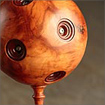 How do you approach blending imaginative storytelling with functional design in your projects?
How do you approach blending imaginative storytelling with functional design in your projects?
Generally, my sculptural work does not intentionally speak to a specific narrative or convey a symbolic message.
Rather my motivation is to create a sculptural vision that suggests an alternate reality that is whimsical, tantalizing and mysterious, with a deep begrimed history. To conjure a dream of peering through an aperture and glimpsing an exotic artifact glowing in the shadows of an opulent world similar to ours, but with intrinsically different colors, quality of light and texture. A world celebrating inviolable design over mere function.
My work is grounded on a personal philosophy I call Intentional Design: every element is functionally there for a reason, designed by one person with a particular vision, and fabricated with technologically adjacent techniques. Adherence to these tenets will hopefully culminate in an object that is pure, elegant in its solutions, and timeless in its phantasm.
My aspiration is to ultimately transcend Craft and enter the rarefied strata of Art.
 For those who do not know you, can you tell us a little bit about Josh “JW” Kinsey, and the type of work you do?
For those who do not know you, can you tell us a little bit about Josh “JW” Kinsey, and the type of work you do?
My background is in fine art: I have a degree in Computer Graphic Imaging. My career path began in the Silicon Valley as an Interface Designer and Digital Artist. From there I owned and operated a high-end custom cabinet shop: it was here that I began to collect my wood and metal working skills. This has culminated in my current endeavor: a small artisan shop specializing in the creation of unique, design-driven projects.
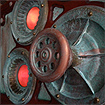 You have said that you are entirely self-taught. Do you believe that just anyone can teach themselves or does it take a certain predisposition?
You have said that you are entirely self-taught. Do you believe that just anyone can teach themselves or does it take a certain predisposition?
Anyone can learn to fabricate simple functional items: that is the definition of craft. To improve ones skills can take years of dedicated, repetitive making: the ceaseless act of doing while continuously pursuing mastery. Possessing an innate natural ability can shorten the timeframe to attain these skills.
What can this innate natural ability manifest as? Traits can include excellent hand/eye coordination, understanding complex construction methodologies, the ability to visualize in three dimensions, good drawing/writing skills combined with the ability to verbally articulate complex ideas, and the ability to understand and manage complex construction design and fabrication sequencing, to name a few. All these, and hopefully a creative spark with a unique voice.
The line where Craft transmutes into Art is a very cerebral and vociferously debated argument. I have not yet encountered a decisive location of the line separating Art from Craft, other than the odd clever euphemism.
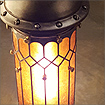 For those interested in learning some of the skills that you have developed, where would you suggest they start?
For those interested in learning some of the skills that you have developed, where would you suggest they start?
I personally learn from the act of doing, from the physicality of creating a specific goal and then learning how to overcome the various obstacles that present themselves on the journey to achieve that goal. I attempt to overcome these obstacles with copious research: the reading of topic related books, asking questions of other artists and craftspeople with esoteric knowledge and more experience than I, internet searches: whatever I can source as I seek solutions.
As a direct result of this data integration, I determine which skill sets or machines I need to learn or acquire. I then make a first attempt, evaluate the results, then do it all again till I have accomplished my specific goal. As a direct result of this skill and tool collecting methodology, my shop is now full of some very unique machines, and I have most of the necessary skill sets that allow me to fabricate Very Interesting Things.
Unfortunately, beyond this approach, I donʼt have a specific “go do this/read this book and you will be a master craftsman.” Iʼve invested over twenty-five years of doing and some $60,000 in equipment to get where I am today, and I am still questing for new techniques and abilities. I still have a few unique machines I would like to someday acquire. Hopefully, this growth process will never stagnate.
 You have designed pieces with thousands of individual components that have to work together just right or the project is a failure. Have you ever hit a road block where you just have to step back and re-evaluate a component of your design?
You have designed pieces with thousands of individual components that have to work together just right or the project is a failure. Have you ever hit a road block where you just have to step back and re-evaluate a component of your design?
As I attempt to plan every fabrication step in detail before construction begins, with copious additional design notes, I fortunately have not yet experienced a design quandary of that magnitude. My goal is to anticipate potential problems before they happen.
However, I avoid planning the detailed minutia within the overall project design: I want to leave room for spontaneity and unexpected design variations within the build. Essentially, I want to have a plan of how I am going to build something, not necessarily exactly what I am going to build: I want a meticulously prepared fabrication vector to play within.
This is an important distinction, intended to allow for very complex builds that aren’t entirely mired down in the specifics of the fabrication process: a methodology that leaves wiggle room for unexpected creative expression to surface during the act of playful making.
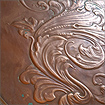 How do you decide what Personal Projects to make?
How do you decide what Personal Projects to make?
Most of it is determined by how much free time I have between commissioned work; whether I can fit a specific “play” project within the cracks. How much verve I have available at the moment is another important element.
Other times I have been unexpectedly slapped by a Muse, and I desperately need to get the vision out of my head to free up mind space. I structure the builds of these projects as a Personal Challenge. These projects are intended to stretch my abilities, to force an exploration of a new skill set, to fabricate a new piece of tool kit; ultimately to compel me to grow as a Craftsman and hopefully as an Artist.
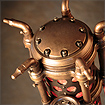 What is the general process implemented to create an entire piece composed of only hand-made components?
What is the general process implemented to create an entire piece composed of only hand-made components?
The vast majority of my pieces are fabricated entirely from raw materials, other than the standard hardware, electrical, and mechanical bits. Rarely a few one-off pieces do integrate some upcycled parts, such as my Newtonian Reflecting Telescopes: they incorporate the optics and equatorial mounts from donor ʻscopes. Also, my Nocturnus series of night-lights are built around extensively shop-modified antique radio carcasses.
The construction process for a new build generally begins with the design phase: the process of taking various loose design sketches and refining the idea into finished construction drawings, complete with scale illustrations and needed dimensions. These drawings are sometimes done by hand with pencil and ruler. If it is a complex piece and I want to ensure the proportions and interrelated details will work, I will utilize various CAD software. For the BioDynamic Lunar Clock, for example, the CAD work alone took a solid three weeks.
Once the construction drawings are complete and I have a solid plan of how to overcome the various construction challenges, I can begin building the prototype.
For example, if I am working on a new light fixture, I will construct the myriad individual components implementing a mix of technologies as required: various parts in woodwork of cherry or maple hardwoods, various inhouse 3D printing methods, laser cutting, or CNC machining. These master patterns are then molded in silicone rubber with plywood mold-jackets: these can be very complex, multiple part molds that typically incorporate cores, core-prints, and bridges. Final parts are cast in an industrial-grade resin that is extremely heavy, dense, and strong- comparable to solid aluminum in heft. Additional parts in various metals may be machined out of billet stock, welded, soldered, or mechanically fastened.
These prototypes can take many weeks to fabricate. For example, the primary body master pattern for the Photonic Siphuncle Primary took a solid three weeks to construct: and that was just one part of several dozen that had to be fabricated, molded, and finally cast into its finished form. Once all the component parts have been produced (a Tessaquinary Table Lamp has some 380 individual elements, the Hubbard Oscillation Back Bar over 7,000!), then surface finishing, any electrical and mechanical work, and then final assembly can commence.
Once prototyping is finished, all requisite molds are built, surface finishes are resolved, and a BOM is in hand, the new design is ready for production on a made-to-order basis. On average, one of my Table Lamps can take some 80 hours to fabricate, and some $5-600 US in raw materials. Larger installations have taken upwards of ten months full time to design and build, depending upon the complexity and scale.
J.W. Kinsey’s work titillates ones humours and fondles the imagination inappropriately, while simultaneously attempting to validate his existence.

